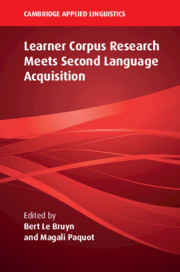Book contents
- Learner Corpus Research Meets Second Language Acquisition
- The Cambridge Applied Linguistics Series
- Learner Corpus Research Meets Second Language Acquisition
- Copyright page
- Contents
- Figures
- Tables
- Contributors
- Series Editors’ Preface
- Learner Corpus Research and Second Language Acquisition: an attempt at bridging the gap
- Article Use in Russian and Spanish Learner Writing at CEFR B1 and B2 Levels: Effects of Proficiency, Native Language, and Specificity
- L1 Influence vs. Universal Mechanisms: An SLA-Driven Corpus Study on Temporal Expression
- The Interplay between Universal Processes and Cross-Linguistic Influence in the Light of Learner Corpus Data: Examining Shared Features of Non-native Englishes
- Exploring Multi-Word Combinations as Measures of Linguistic Accuracy in Second Language Writing
- Using Syntactic Co-occurrences to Trace Phraseological Complexity Development in Learner Writing: Verb + Object Structures in LONGDALE
- Understanding the Long-Term Evolution of L2 Lexical Diversity: The Contribution of a Longitudinal Learner Corpus
- L2 Developmental Measures from a Dynamic Perspective
- Exploring Individual Variation in Learner Corpus Research: Methodological Suggestions
- Building an Oral and Written Learner Corpus of a School Programme: Methodological Issues
- Commentary: Have Learner Corpus Research and Second Language Acquisition Finally Met?
- Commentary: An SLA Perspective on Learner Corpus Research
- Index
- References
Exploring Multi-Word Combinations as Measures of Linguistic Accuracy in Second Language Writing
Published online by Cambridge University Press: 29 December 2020
- Learner Corpus Research Meets Second Language Acquisition
- The Cambridge Applied Linguistics Series
- Learner Corpus Research Meets Second Language Acquisition
- Copyright page
- Contents
- Figures
- Tables
- Contributors
- Series Editors’ Preface
- Learner Corpus Research and Second Language Acquisition: an attempt at bridging the gap
- Article Use in Russian and Spanish Learner Writing at CEFR B1 and B2 Levels: Effects of Proficiency, Native Language, and Specificity
- L1 Influence vs. Universal Mechanisms: An SLA-Driven Corpus Study on Temporal Expression
- The Interplay between Universal Processes and Cross-Linguistic Influence in the Light of Learner Corpus Data: Examining Shared Features of Non-native Englishes
- Exploring Multi-Word Combinations as Measures of Linguistic Accuracy in Second Language Writing
- Using Syntactic Co-occurrences to Trace Phraseological Complexity Development in Learner Writing: Verb + Object Structures in LONGDALE
- Understanding the Long-Term Evolution of L2 Lexical Diversity: The Contribution of a Longitudinal Learner Corpus
- L2 Developmental Measures from a Dynamic Perspective
- Exploring Individual Variation in Learner Corpus Research: Methodological Suggestions
- Building an Oral and Written Learner Corpus of a School Programme: Methodological Issues
- Commentary: Have Learner Corpus Research and Second Language Acquisition Finally Met?
- Commentary: An SLA Perspective on Learner Corpus Research
- Index
- References
Summary
While written language development involves reducing erroneous expressions, traditional error-based measures are problematic for several reasons, including low inter-coder reliability for lexical errors, limited sensitivity for capturing development within a short time period, and the questionable separation of lexical and grammatical errors. Given these problems, we explore automated accuracy measures rooted in a usage-based theory of Second Language Acquisition, which views language as a set of constructions or chunks. For this study, we examined 139 essays in terms of using traditional measures of complexity, accuracy, lexical sophistication, and fluency, as well as novel corpus-based n-gram measures. A factor analysis was conducted to explore how traditional measures grouped with corpus-based measures, and regression analyses were used to examine how corpus-based measures predicted error counts and holistic accuracy scores. With the results of these analyses, we suggest that automated n-gram based measures are a viable alternative to traditional accuracy measures.
- Type
- Chapter
- Information
- Learner Corpus Research Meets Second Language Acquisition , pp. 96 - 121Publisher: Cambridge University PressPrint publication year: 2021

